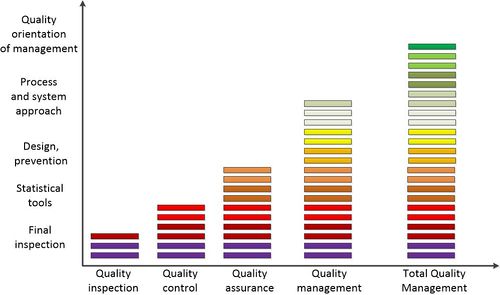Quality assurance
| Quality assurance |
|---|
| See also |
Quality assurance is based on idea of prevention of failures. It's the next stage of quality approach development, after quality inspection and quality control. It was superseded by quality management.
The quality assurance moves the focus to the earlier stages of the production process than quality control. However it should be noted, that quality assurance includes all the methods of quality inspection and quality control and adds two new concepts:
- right first time,
- fitness to use.
The quality assurance is a system of double feedback loop. The first feedback loop sends information about quality to workers, like in case of quality control. This enables workers to improve quality of work. The second loop sends information to managers, designers and technologists. This enables them to improve product, technology and production system.
The idea of quality assurance was a natural step forward from quality control. It's principles were created by William Edwards Deming, Joseph M. Juran and Armand Feigenbaum.
Right first time
Failures of products detected by quality inspectors at the end of production line come from two sources: poor design (see below: fit to use) and poor performance. The latter can be divided into low quality of work and low quality of management.
Quality of work
Quality of work is related to all work done by employees, excluding managers. The typical signals of low quality of work are:
- workers comes to work tired and sleepy,
- workers are inattentive during work,
- absenteeism,
- employee attrition,
- workers don't care for the product they make,
- workers don't inform about problems with machines or process.
In short: if workers are not engaged into the work, the quality of work is low. This leads to low quality of products.
In quality assurance we put emphasis on improving quality of work. The workers should be engaged and aim to make their work right the first time. To help them several methods are used e.g.:
The help can be also correct equipment of workplace, including:
- Product specification,
- Technical drawings,
- Measuring tools,
- Sample products,
- Tools of high quality,
- Tools enabling quick communication.
It should be noted, that according to William Edwards Deming, quality of work is responsible for only about 20% of product quality. The rest is quality of management.
Quality of management
Quality of management is related to work performed by managers, who organize production processes. It's responsible for 80% of product quality. Poorly managed workers, even striving to make good product, simply can't achieve this. Quality of management can be observed in production line through e.g.:
- short transport lines,
- no overproduction,
- no workers without job,
- all workplaces having necessary raw materials,
- short downtimes,
- no broken machines,
- well equipped workplaces (see earlier: quality of work).
There are methods that help managers increase quality of management in production, e.g.:
- Heijunka,
- Total Productive Maintenance,
- 7 quality tools,
- Quality loss function,
- Good manufacturing practice,
- Organization of production space,
- Transport routes optimization.
Quality of management is much wider term in quality management context. It is not limited to production only, but refers to whole organization. This meaning is described in separate article: Quality of management.
Fitness to use
Fitness to use refers to product design. The product and production technology should be designed in such a way, that the probability of errors is minimal, as well as features of the product are important to the customer and satisfy him. To achieve this, designers and technologists should use appropriate methods, e.g.:
The idea of fitness to use is wider described in article: Designed quality.
References
- Quality assurance vs. quality control (ASQ)
- History of quality (ASQ)
- Bogue EG, Saunders RL (1992) The Evidence for Quality, Jossey-Bass Inc, San Francisco
- Mahfout M, Gama MA, Panoutsos G (2008) “Right-First-Time” Production: A Reality or a Myth?, Materials and Manufacturing Processes, Volume 24, Issue 1
Author: Slawomir Wawak
